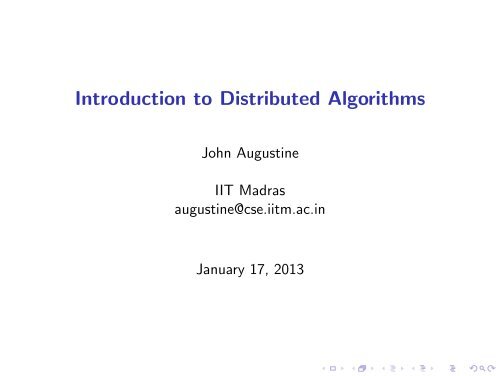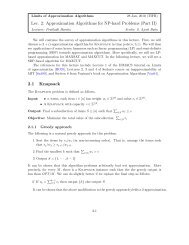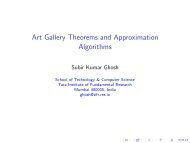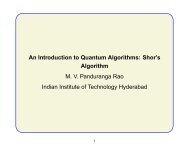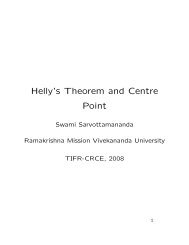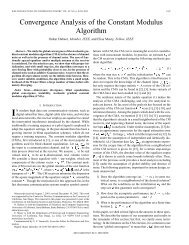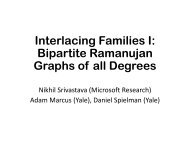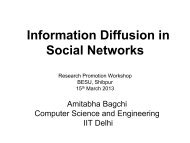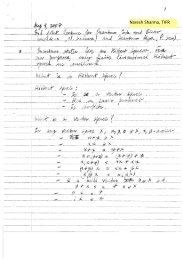Introduction to Distributed Algorithms
Introduction to Distributed Algorithms
Introduction to Distributed Algorithms
Create successful ePaper yourself
Turn your PDF publications into a flip-book with our unique Google optimized e-Paper software.
<strong>Introduction</strong> <strong>to</strong> <strong>Distributed</strong> <strong>Algorithms</strong><br />
John Augustine<br />
IIT Madras<br />
augustine@cse.iitm.ac.in<br />
January 17, 2013
Lets Start @ the Very Beginning . . .<br />
Pre-60’s: Telephone, telegram and postal networks.<br />
→ Borůvka’s Algorithm for MST invented in 20’s<br />
60’s and 70’s: Mostly small networks, simple <strong>to</strong>pologies.<br />
→ DARPA starts arpanet.<br />
80’s: Larger networks (mostly in-house in large<br />
organizations).<br />
→ Email and other Internet technologies taking<br />
shape.<br />
→ Fisher, Lynch and Paterson show that<br />
deterministic agreement is impossible in faulty<br />
asynchronous networks.
The Big Bang<br />
90’s: The Internet breaks in<strong>to</strong> the scene.<br />
→ Cell phones become popular in many countries.<br />
→ PageRank algorithm invented at Stanford.<br />
Google starts operation from a garage.<br />
→ <strong>Distributed</strong> algorithms is established firmly.
The Expanding Universe of Networks<br />
2000’s: Ubiqui<strong>to</strong>usly connected lifestyle<br />
→ Cell Smart phones become popular in India.<br />
→ Social Networks, P2P networks, . . .<br />
→ Cloud computing, big data, . . .
Overview<br />
1 Agreement<br />
2 Leader Election<br />
3 Minimum Spanning Tree<br />
4 Maximal Independent Set
Audience Participation<br />
→ Choose a number: 37 or 43.<br />
→ You may communicate with your neighbours.<br />
→ Goal: everybody must agree on same number.<br />
Either number is fine. Just reach agreement!<br />
What lessons can we learn
Model or Setting<br />
The number of models in distributed computing is only<br />
slightly smaller than the number of papers published.<br />
— David Peleg
Model or Setting<br />
<strong>Distributed</strong>. Graph G = (V , E).<br />
→ Each node is a computer<br />
→ Nodes have unique ids (think ip address)<br />
→ Edges indicate communicability<br />
→ Possibly weighted — bandwidth, transmission<br />
cost, energy cost, etc.<br />
Synchronous. Common clock tick. Rounds 1, 2, 3, . . .<br />
→ Not realistic, but helpful in gaining traction.
Model or Setting<br />
Message Passing. If e = (u, v) ∈ E, then u and v can directly<br />
send messages <strong>to</strong> each other.<br />
CON GEST . Size of each message is O(log n), where n = |V |.<br />
→ Why O(log n) Why not O( √ n)<br />
In Each round r, each node executes following steps in sequence.<br />
1 Perform local computation.<br />
2 Send messages <strong>to</strong> neighbours.<br />
3 Receive messages.
The Agreement Problem<br />
Input. Each node starts with a bit value from {0, 1}.<br />
Goal. Achieve following conditions.<br />
Agreement. Every node must “output” the same<br />
bit value.<br />
Validity. At least one node must have started<br />
with the agreed bit value.<br />
Termination. Must terminate and nodes must know<br />
when algorithm terminates.
Algorithm for the Agreement Problem<br />
1<br />
0<br />
0<br />
1<br />
0<br />
0<br />
0<br />
1<br />
0<br />
0<br />
1<br />
0<br />
1<br />
0<br />
1<br />
0 0<br />
0<br />
0<br />
0<br />
0
Algorithm for the Agreement Problem<br />
1<br />
01<br />
10<br />
1<br />
0<br />
01<br />
01<br />
1<br />
01<br />
01<br />
1<br />
01<br />
1<br />
01<br />
1<br />
01 01<br />
01<br />
0<br />
0<br />
10
Algorithm for the Agreement Problem<br />
1<br />
01<br />
10<br />
1<br />
01<br />
01<br />
01<br />
1<br />
01<br />
01<br />
1<br />
01<br />
1<br />
01<br />
1<br />
01<br />
01 01<br />
01 01<br />
10
Algorithm for the Agreement Problem<br />
How many rounds are required <strong>to</strong> reach agreement<br />
O(diameter) rounds<br />
(Nodes need <strong>to</strong> know the diameter.)<br />
What happens when there are NO nodes starting at 1<br />
Validity maintained.
Algorithm for the Agreement Problem<br />
How many rounds are required <strong>to</strong> reach agreement<br />
O(diameter) rounds<br />
(Nodes need <strong>to</strong> know the diameter.)<br />
What happens when there are NO nodes starting at 1<br />
Validity maintained.
Algorithm for the Agreement Problem<br />
How many rounds are required <strong>to</strong> reach agreement<br />
O(diameter) rounds<br />
(Nodes need <strong>to</strong> know the diameter.)<br />
What happens when there are NO nodes starting at 1<br />
Validity maintained.
Algorithm for the Agreement Problem<br />
How many rounds are required <strong>to</strong> reach agreement<br />
O(diameter) rounds<br />
(Nodes need <strong>to</strong> know the diameter.)<br />
What happens when there are NO nodes starting at 1<br />
Validity maintained.
How Good is the Algorithm<br />
Time complexity. O(diameter)<br />
Message complexity. O(diameter × m) O(m). (Here m = |E|.)<br />
Can we achieve O(n)
How Good is the Algorithm<br />
Time complexity. O(diameter)<br />
Message complexity. O(diameter × m) O(m). (Here m = |E|.)<br />
Can we achieve O(n)<br />
Use a spanning tree!
How Good is the Algorithm<br />
Time complexity. O(diameter)<br />
Message complexity. O(diameter × m) O(m). (Here m = |E|.)<br />
Can we achieve O(n)<br />
Use a spanning tree!<br />
Will that affect running time
Agreement<br />
<br />
−→ Leader Election
Agreement<br />
<br />
−→ Leader Election<br />
Each node performs the following.<br />
1: Generate a random number (with sufficiently many bits).<br />
2: Initialize (r, id) pair with r being its own random number and<br />
id being its own id.<br />
3: for i ← 1 <strong>to</strong> diameter do<br />
4: Send (r, id) pair <strong>to</strong> neighbours.<br />
5: Receive (r, id) pairs from neighbours.<br />
6: Update its (r, id) pair if a bigger r value is received.<br />
7: end for
Minimum Spanning Tree (MST)<br />
→ Recall MST: spanning tree of G whose <strong>to</strong>tal edge weights is<br />
minimum.<br />
→ Goal: each node must know which of its incident edges belong<br />
<strong>to</strong> the MST and which do not.<br />
→ W.L.O.G., assume that all edge weights are distinct.<br />
This implies a unique MST.
MST Basics<br />
→ Let T M be the (unique MST) of G.<br />
→ A fragment is a connected subtree of T M .<br />
→ An outgoing edge of a fragment is an edge in E where one<br />
adjacent node <strong>to</strong> the edge is in the fragment and the other is<br />
not.<br />
→ The minimum weight outgoing edge (MOE) of fragment T is<br />
called M(T ).<br />
→ The following rule produces a MST.<br />
→<br />
Blue rule: Pick a fragment T and add M(T ) <strong>to</strong> it (until<br />
possible).
Synchronous GHS Algorithm<br />
(Gallager, Humblet, and Spira)<br />
→ Each node begins as a fragment by itself<br />
→ All nodes end as one fragment — the MST.<br />
→ Every fragment will have exactly one root node.<br />
→ Each nodes in the fragment will know its parent and children.<br />
→ Each fragment is identified by the identifier of its root and<br />
each node knows this.
Finding Minimum Weight Outgoing<br />
Edge<br />
→ Root broadcasts a “command” <strong>to</strong> all nodes in the fragment<br />
using the edges in the fragment.<br />
→ Each node, on receiving command, checks its neighbours (in<br />
increasing order of weight.)<br />
→ (Once an edge is known <strong>to</strong> lead <strong>to</strong> another node in the same<br />
fragment, it is not considered again.)<br />
→ Each node reports its candidate MOE <strong>to</strong> the root by a<br />
prioritized convergecast.<br />
Only smaller weight edges progress <strong>to</strong>ward root.
Combining Fragments<br />
→ Each fragment combines with the fragment at the other end<br />
of the edge.<br />
→ If other fragment also selected the same edge:<br />
Two fragments agree <strong>to</strong> combine at that point.<br />
Endpoint with higher id becomes new root.<br />
→ The (combined) root broadcasts a ”new-fragment” message<br />
through the fragment edges and the MOE edges.<br />
→ Each node updates its parent, children, root identifier.
Correctness<br />
→ The algorithm essentially follows the blue rule.<br />
→<br />
Can a cycle be formed when merging fragments<br />
→ A directed graph is weakly connected if its undirected version<br />
is connected.<br />
Lemma<br />
A weakly connected digraph in which each vertex has exactly one<br />
outgoing edge has exactly one cycle.<br />
Proof Hint.<br />
Use induction. (See figure next slide.)
Illustration of Lemma
Correctness<br />
→ Consider the digraph F on the fragments connected by MOE<br />
edges.<br />
The directions indicate which fragment wants <strong>to</strong> connect <strong>to</strong><br />
which other fragment.<br />
Each fragment has exactly one outgoing edge.<br />
→ Therefore, by Lemma 1, each weakly connected component of<br />
F has exactly one cycle.
Consider cycles in F .<br />
Correctness<br />
6<br />
5<br />
3<br />
13<br />
8<br />
3<br />
4<br />
9<br />
10<br />
1<br />
2
Correctness<br />
Consider cycles in F . They must contain exactly two fragments.<br />
6<br />
OK<br />
5<br />
3<br />
13<br />
8<br />
3<br />
4<br />
9<br />
10<br />
1<br />
2<br />
Note same weights
Complexity Analysis<br />
→ O(log n) phases.<br />
→ Each phase takes O(n) time.<br />
⇒ Hence, time complexity is O(n log n).<br />
→ Each phase takes O(n) messages (for convergecast and<br />
broadcast) plus the messages needed <strong>to</strong> find MOE.<br />
→ The latter takes a <strong>to</strong>tal of O(|E|) for the entire algorithm,<br />
because, a node checks a neighbour at most once.<br />
⇒ Hence <strong>to</strong>tal message complexity is O(|E| + n log n).
Maximal Independent Set Problem<br />
Defn. A set of nodes is called an independent set if it contains no<br />
pair of neighboring nodes.<br />
Defn. An independent set is maximal if it cannot be increased <strong>to</strong><br />
form a larger independent set by the addition of other nodes.<br />
→ Given an arbitrary network we want <strong>to</strong> find a maximal<br />
independent set of nodes.<br />
→ Each node must know if it is in MIS or not.<br />
Appln. dominating sets, clusterhead selection ..
High Level Idea<br />
Notation Let Γ(v) be the set of vertices in V that are adjacent <strong>to</strong> v.<br />
Idea The algorithm proceeds in rounds; In every round<br />
1 find an independent set S,<br />
2 add S <strong>to</strong> I (initially I is empty) and<br />
3 delete S ∪ Γ(S) from the graph.
Luby’s Algorithm I<br />
1: Uncolour all vertices.<br />
2: for O(log n) rounds do<br />
3: Nodes with degree 0 are coloured red and removed.<br />
4: Each node v marks itself with prob<br />
1<br />
2d(v)<br />
5: If two endpoints of an edge are coloured, unmark lower<br />
degree endpoint (breaking ties arbitrarily).<br />
6: Colour all marked nodes red<br />
7: Colour neighbours of red nodes blue (in parallel)<br />
8: Remove coloured nodes.<br />
9: end for
Analysis<br />
Key Idea: Constant fraction of edges removed each round (on<br />
exp.)<br />
v ∈ V is good if at least d(v)/3 neighbors of degree no more<br />
than d(v); otherwise the vertex is bad.<br />
Good Vertex<br />
Bad vertex<br />
An edge is good if at least one of its endpoints is a good<br />
vertex<br />
bad if both endpoints are bad vertices.<br />
We show that a good vertex is likely <strong>to</strong> have one of its lower<br />
degree neighbors in MIS and thereby deleted from V .
Lemma<br />
Let v ∈ V be a good vertex with degree d(v) > 0. Then, the<br />
probability that some vertex w ∈ Γ(v) gets marked is at least<br />
1 − e −1/6 .<br />
Proof.<br />
Each vertex w ∈ Γ(v) is marked independently with<br />
probability 1/(2d(w)).<br />
The probability that none of the neighbors of v gets marked is<br />
at most (<br />
1 − 1 ) d(v)/3<br />
≤ e −1/6<br />
2d(v)<br />
Note: 1 − e −1/6 = 0.153518275, which is small, but nevertheless a<br />
constant!
Lemma<br />
During any round, if a vertex w is marked then it is coloured red<br />
with probability at least 1/2.<br />
Proof.<br />
The only reason a marked vertex w becomes unmarked is that<br />
one of its neighbors of degree at least d(w) is also marked.<br />
The probability of this happening is<br />
∑<br />
x∈Γ(w)<br />
1<br />
2d(x) ≤<br />
∑<br />
x∈Γ(w)<br />
1<br />
2d(w) = d(w)<br />
2d(w) = 1/2
Lemma<br />
The probability that a good vertex is either coloured red or blue in<br />
one iteration is at least<br />
(1 − e −1/6 )/2.<br />
Note: 1−e−1/6<br />
2<br />
= 0.0767591376, a constant!
Lemma<br />
In a graph G = (V , E) the number of good edges is at least |E|/2.<br />
Proof.<br />
Direct the edges in E from the lower degree end-point <strong>to</strong> the<br />
higher degree end-point breaking ties arbitrarily. Let d i (v) and<br />
d o (v) be the in-degree and out-degree of v.<br />
For each bad vertex v,<br />
Therefore,<br />
d o (v) − d i (v) ≥ d(v)/3 = d o(v) + d i (v)<br />
3<br />
d o (v) ≥ 2d i (v). (1)<br />
The number of edges going in<strong>to</strong> a bad vertex is at most half<br />
the number of edges going out of that bad vertex.<br />
Therefore, the number of edges going in<strong>to</strong> bad vertices is at<br />
most half the number of edges going out of bad vertices.
Proof (contd.)<br />
.<br />
Let E(S, T ) be the set of edges directed from vertices in S <strong>to</strong><br />
vertices in T ; and e(S, T ) = |E(S, T )|.<br />
Let V G and V B be the good and bad vertices, respectively.<br />
|e(V B , V B )| + |e(V G , V B )| ≤ 1 2 (|e(V B, V B )| + |e(V B , V G )|)<br />
Therefore,<br />
|e(V B , V B )| ≤ |e(V B , V G )|,<br />
implying that # of bad edges are less than the # of good<br />
edges.
The Final Touch<br />
Corollary<br />
On expectation, at least 1−e−1/6 |E|<br />
4<br />
edges are deleted in each<br />
iteration. I.e., |E| × 0.0383795688 edges are deleted in each<br />
iteration.<br />
Theorem<br />
Therefore, the expected number of iterations is O(log n).
1: {Each node executes the following code.}<br />
2: while not deleted do<br />
3: Generate a random number r.<br />
Luby’s Algorithm II<br />
4: Send your random number <strong>to</strong> neighbours.<br />
5: Receive neighbours’ random numbers. Let r ′ be the max<br />
among neighbours’ random numbers.<br />
6: if r > r ′ then<br />
7: Put self in MIS.<br />
8: Send “delete” command <strong>to</strong> neighbours<br />
9: end if<br />
10: Delete self if “delete” command received.<br />
11: end while


